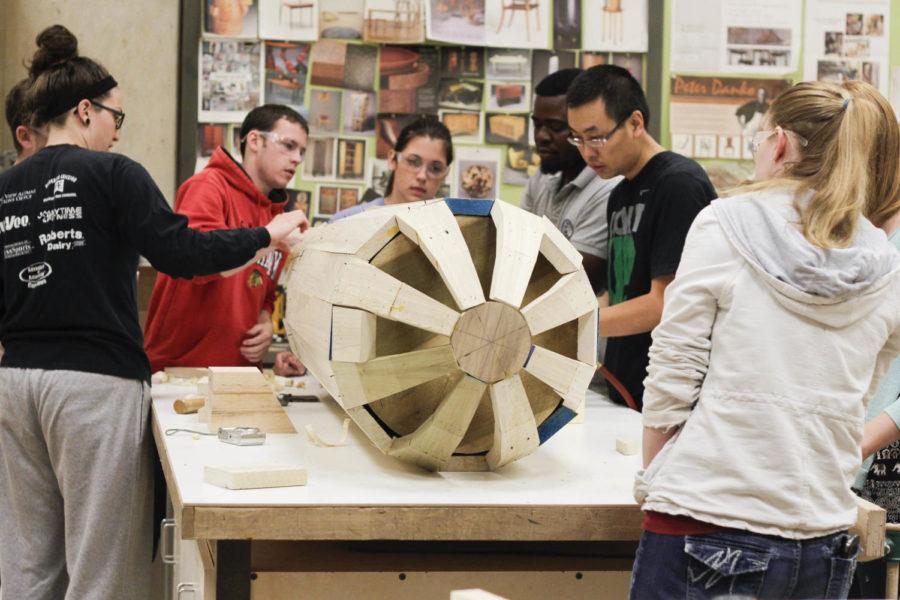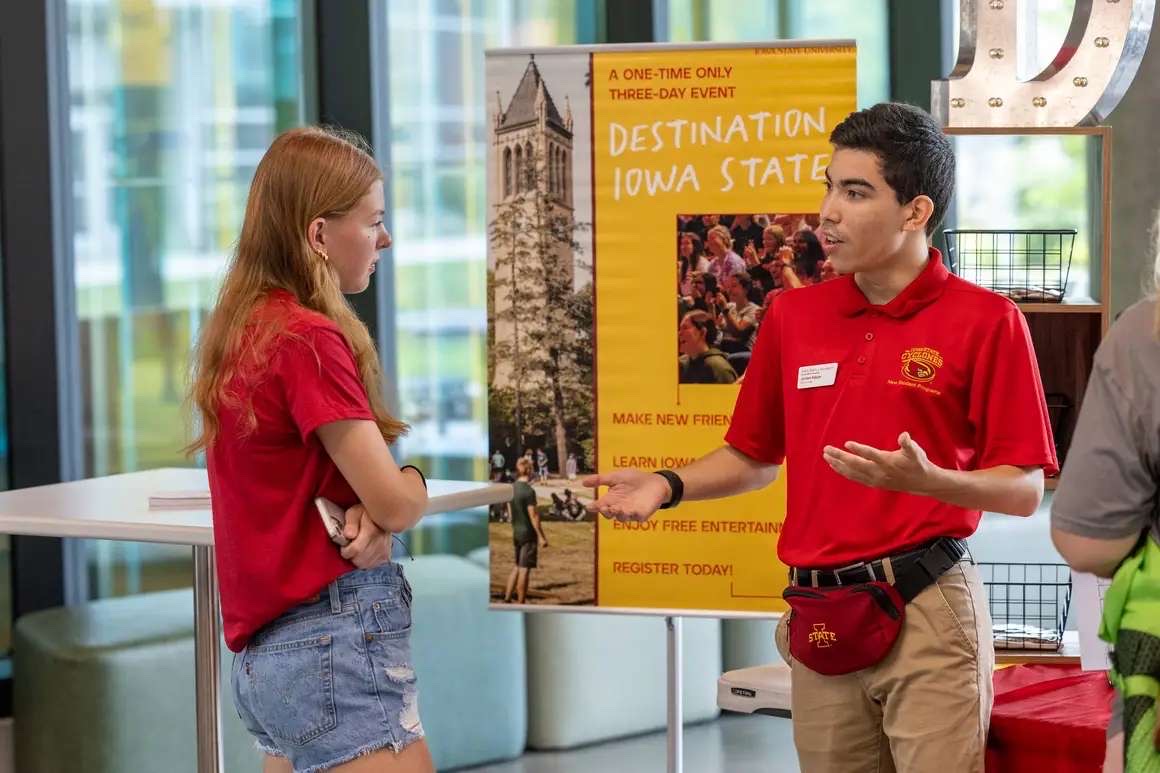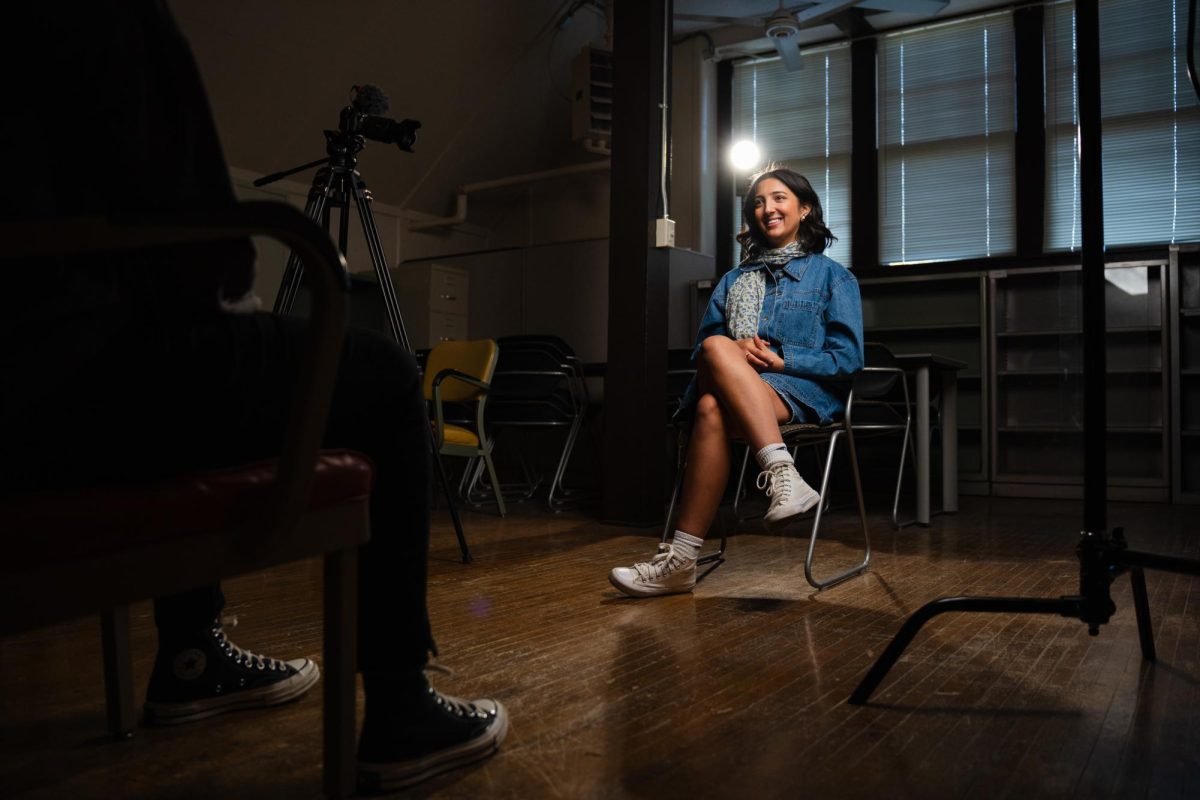‘Going out in style’: Ghanaian artist brings expressive coffin art to College of Design
Tiffany Herring/Iowa State Daily
The integrated studio arts furniture design class worked with Eric Adjetey Anang on Sept. 16 to create a fantasy coffin. Anang will work with students to create a coffin shaped like an ear of corn.
September 17, 2014
Sitting around a shop in the basement of the College of Design, Eric Adjetey Anang and Chris Martin, associate professor of integrated studio arts, joke about which kind of coffin Anang will be buried in. While the subject might seem morbid to many, it is a daily topic for Anang as he is a Ghanaian fantasy coffin artist.
Kicking off his visit, Anang gave his presentation, “Going Out in Style” at the Memorial Union where he spoke on the history and purpose of his art. Throughout the week, he will be working on constructing a coffin in the shape of an ear of corn, which will be auctioned off at an event for ISU Engineers Without Borders project. The project is creating a water retention system for a village in northern Ghana.
Students can view Anang working on the coffin from 8 to 11 a.m. Wednesdays and Fridays and 9:30 to 11 a.m. Thursdays on the lower level patio behind the College of Design.
“I feel [the culture] should be shared all over the world because this is so special,” Anang said. “This is a way to celebrate the deceased.”
Starting in the early 1950s, Anang’s grandfather, Seth Kane Kwei, created a unique figurative palanquin — the platform that carries a coffin — after the death of a Ghanaian tribal chief. Not long after, Kwei’s grandmother — a woman who dreamed of one day flying in an airplane but never did — died. To mimic her curiosity, Kwei created a coffin modeled after an airplane. The coffins began representing the deceased’s profession or something her or she valued in life.
Kwei’s creations became something at which to marvel, admirers said. Because of his grandfather’s talents, Anang’s interest in creating coffins started at a young age. While he was only 8 years old when Kwei died, he recalledays spent in his grandfather’s carpentry shop.
“All I remember is sometimes, when they were working, we would go around the shop just to follow him,” Anang said. “We even slept on [the coffins]. Your dad, or someone is carrying you when you fall asleep, they just put you on one of the coffins.”
Anang’s father took over the Kane Kwei Carpentry Workshop. When requesting to work for his father, Anang was denied. His father wished for him to receive a degree in something different than carpentry. However, Anang did not want to follow the crowd.
“I said to myself, ‘why don’t I also create something for myself,’ and by doing so, I knew this job was there, that I could get into it and gain a whole lot of support,” Anang said.
Anang spent three years working for his father for no pay, going into the shop after classes, but his classes weren’t required for the job.
“Most of the carpenters we have basically happen to be people who are not fully educated, so they cannot come out and fully express whatever they are doing,” Anang said.
Anang’s fresh ideas for the shop created tension with his father and uncle’s poor management techniques, he said.
Only using nails, glue and soft wood — which decays more quickly — Anang constructs the coffins to be painted. The coffins’ shape reflects what the deceased valued while the paint, which is done by an artist, emphasizes the coffin.
Attempting to find new ways to display his art, doors opened for Anang when a commercial shown in Europe featured his fantasy coffins. Within the last few years, Anang has been given the opportunity to show his work in various parts of the world, including Russia, South Korea, Italy and the United States. During the time Anang is touring in America, the family shop is in a trial period without his guidance.
“When I’m back home, I basically do almost 60 percent of the job, and the other 40 percent is being done by apprentices,” Anang said. “While I’m away for this period of time, all the time I keep having to be telling them and giving them directions on where they could get such things, from whom and how.”
However, the artistic coffins are not well accepted in Ghana as forms of art.
“I tried a couple of times to exhibit the coffins in Ghana,” Anang said. “Usually it was very tough because the mentality was all the time [that] it’s a coffin, so you can’t display it among places where people are.”
Martin had already seen Anang’s work in 1990, but he was able to experience it again when he visited Ghana as a part of his work in the Peace Corps for 27 months starting in 2008. Since 2011, Martin and other ISU faculty have actively been trying to get Anang to visit Iowa State in hopes of giving the design students a global perspective on art.
“If I can present them with as large of breadth of skills and concepts and ideas as possible, that’s kind of what I want to do,” Martin said.
Students in a beginning level color theory class taught by Cindy Gould, associate professor of integrated studio arts, will be assisting Anang in painting the coffin being constructed outside of the College of Design.
“I’m seeing the coffin as it’s being produced and it’s going to be a stylized shape,” Gould said. “It will still be recognizable as an ear of corn and I think to help emphasize what it is, we will stay within the more traditional range of colors.”
Students will submit their own templates for an ear of corn and one will be selected, but only after doing research about Anang, coffin art, and attending his presentation.
Many students, including Yuma Izumi, sophomore in integrated studio arts, found Anang’s family’s work inspiring.
“I thought it was kind of inspiring that in Ghana his grandfather made death as more of, not a mourning, but a thing to celebrate,” Izumi said. “[It is] something that is more of life.”







